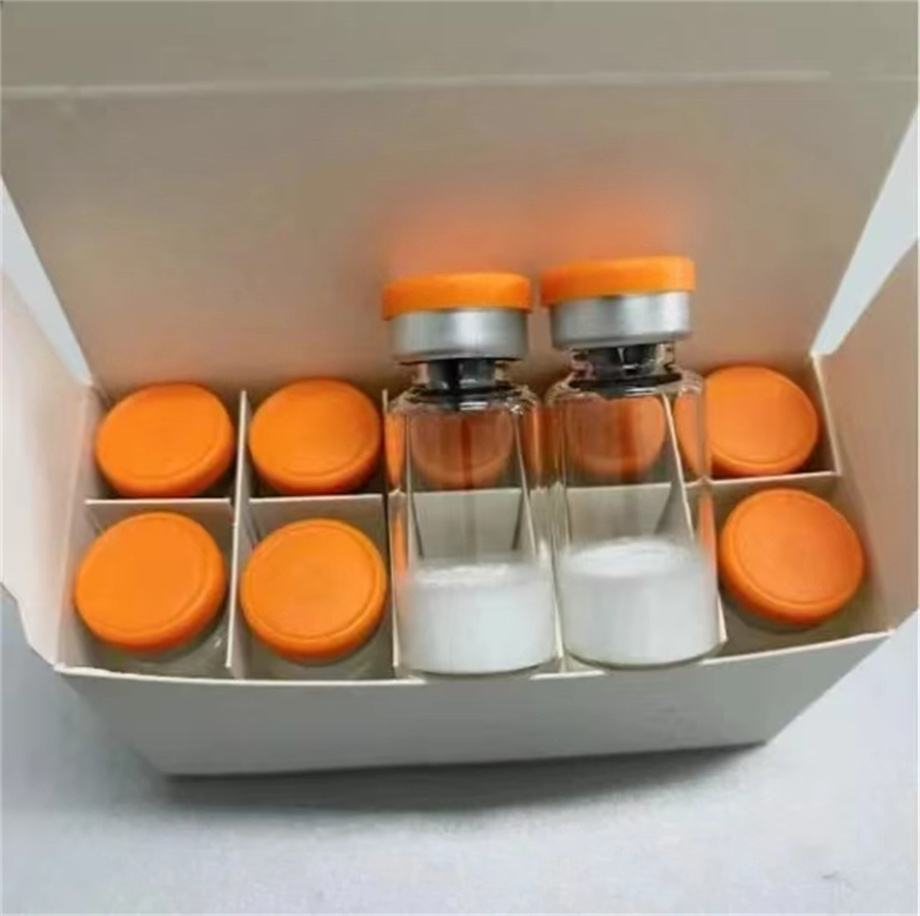1. Increase the use of adults as the main energy source to achieve the effect of fat reduction.
2. Contribute to anti-aging.
3. Increase nutrient transport and utilization efficiency (e.g., protein synthesis)
4. Increase the ability of nerve cell repair and regeneration.
5. Increase the ability of your cells to proliferate, giving you fuller muscles.
Physiology of IGF-1
IGF-1, also known as Somatomedin-C, is a peptide growth factor. IGF-1 can be produced by a variety of tissues in the body, but the most important source is the liver. IGF-1 is synthesized and secreted by the liver under the control of Growth hormone stimulation.
Growth hormone (GH; GH) is secreted by the anterior pituitary gland and its main function is to control the growth of cells, bones and muscles in the human body and maintain the normal function of organs.
The secreted GH enters the blood, and after a few minutes is absorbed by the liver, where it is converted into different growth factors, the most important of which is insulin-like growth factor (IGF-1; Insulin-like growth factor 1). Almost all the functions of GH, including promoting bone growth, synthesizing protein, increasing muscle tissue, reducing trace amounts, lowering cholesterol, and regulating glucose, insulin, must be accomplished with the synergistic promotion of IGF-1. Therefore, IGF-1 has been likened. It is a kind of “channel”, because many other hormones must also cooperate with IGF-1, that is, must first pass through this “channel” to play its normal function.
What are the different mechanisms of action of IGF-1 and IGF-1 LR3 in the body?
IGF-1, as mentioned earlier, is a kind of insulin-like growth factor. After the secretion of GH in the pituitary gland, these hormones are transmitted from the hypothalamus through neurotransmitters to stimulate the production of IGF-1 in the liver.
While IGF-1 LR3 contains proteins that play important roles in mammalian growth and development, IGF1 LR3 (insulin growth factor-1 long arginine 3) Insulin-like growth factor-1-long chain arginine 3 is also known as IGF. IGF1 LR3 is also known as long R3 IGF-1 or IGF-I-Arg-Arg3.
LR3 IGF-1 is more potent than conventional IGF-1 due to its binding rate to pure IGF list binding proteins, which normally inhibit the biological action of IGFs. IG-1 LR3 and IGFs have been shown to have better efficacy and function.
Igf-1 extended IGF-1 LR3 analogs were generated to increase the biological activity of the IGF peptide.
It is an 83-amino acid human recombinant non-glycosylated IGF1 LR3 with a molecular weight of 9200, also known as long R3 IGF-1 or IGF-I-Arg-Arg3. MIM 139250) promotes a number of growth effects, IGF-1 LR3 is a long-chain analogue of human IGF-1 designed and manufactured specifically for mammalian cell culture to support large-scale drug production. Early studies showed that GH did not stimulate sulfate into the plasma directly, or by serum factors called “sulfation factors”, which later became known as “growth factors”.
Along with steroids, IGF-1 will increase the stimulation intensity of steroids (which have the ability to increase satellite cell capacity), physical properties, and the user’s strength and endurance much more.
The most potent form of IGF-1 is thought to be IGF-1 LR3. The structure has been chemically altered and binds to proteins in the human body with an increased half-life, which can last up to about 20-30 hours in the human body.
Association of IGF-1 LR3 and muscle growth
Igf-1 LR3 is designed to increase the biological activities of IGF peptides, the most active of which are to increase the efficiency of amino acid and glucose utilization, promote protein synthesis and reduce protein breakdown. For energy conversion, IGF-1 LR3 is used to reduce energy production as much as possible in adult tissues, while IGF-1 LR3 prevents insulin from transporting glucose across the cell membrane and increases protein synthesis and amino acid absorption in re-muscle tissues. So cells must switch to burning poorly as energy.
IGF-1 LR3 establishes new muscle cells by promoting nitrogen retention and protein synthesis and causes muscle growth by hyperplasia (increased number of muscle cells) and mitosis (actual growth of new muscle fibers). Therefore, IGF-1 LR3 not only causes Hypertrophy of muscle fibers but also increases the number of muscle cells (Hyperplasia) and is more effective than steroids in muscle growth. Taken together, IGF can alter the genetic capacity in muscle tissue and cell count, increasing and distinguishing the number and type of cells present.
Note:
The main efficacy of AAS is the second column, that is, muscle hypertrophy is the effect of AAS
The main effect of IGF, HGH is the third column, which is to increase the number of muscle cells is the effect of IGF, HGH.
Half-life of IGF-1 LR3 and its effect on IGF-1
IGF-1 LR3 has a much longer half-life than the other forms, nearly 20 to 30 hours. When active, IGF-1 LR3 has multiple effects on the organization in muscle cells, and IGF-1 LR3 promotes stem cell proliferation and division. IGF-1 LR3 increased satellite cell viability (enhancing steroid stimulation), muscle DNA, muscle protein content, muscle mass and muscle cross-sectional area; The advantage of IGF-1 LR3 is that it can significantly promote muscle growth. Combined with weight training and steroid use, these effects were significantly enhanced.
Chemical information of IGF-1 LR3:
Molecular weight: 9117.5 g/mol
Molecular formula: C400H625N111O115S9
CAS number: 946870-92-4
Amino acid sequence: Met-Phe-Pro-Ala-Met-Pro-Leu-Ser-Ser-Leu-Phe-Val-Asn-Gly-Pro-Arg-Thr-Leu-Cys-Gly-Ala-Glu-Leu -Val-Asp-Ala-Leu-Gln-Phe-Val-Cys-Gly-Asp-Arg-Gly-Phe-Tyr-Phe-Asn-Lys-Pro-Thr-Gly-Tyr-Gly-Ser-Ser-Ser -Arg-Arg-Ala-Pro-Gln-Thr-Gly-Ile-Val-Asp-Glu-Cys-Cys-Phe-Arg-Ser-Cys-Asp-Leu-Arg-Arg-Leu-Glu-Met-Tyr -Cys-Ala-Pro-Leu-Lys-Pro-Ala-Lys-Ser-Ala
Side effects of IGF-1
Athletes and bodybuilders are often treated by using this class of drugs for enhanced muscle growth, strength and endurance, including growth hormones (GH), IGF-1, steroids, selective androgen receptor modulators (SARMS), etc.
IGF-1 LR3 can improve anabolic capacity, and many fitness websites and peptide (peptide) studies have shown that peptide hormone injections can affect the endocrine system and metabolism. “Although IGF-1LR3 lowers blood glucose, it also enhances tumor cell growth because it promotes the growth of all cellular tissues, and headache is a common side effect of IGF-1LR3 injections.”
Applications of IGF-1 in anti-aging
IGF-1 has become the focus of many researchers, which is regarded as the most important “youth-promoting factor” stimulated by growth hormone (GH). Because so far, no substance has been found to slow down the process of human life expectancy more than IGF-1. Researchers have found that proper IGF-1 levels can replace all the symptoms that aggravate the symptoms and make people live longer, healthier and more active lives. Because IGF-1 can rally sagging muscles, lower the adult body, and help rebuild muscle, bone, and nerve cells.
Although IGF-1 has so many benefits, it is unfortunate that after the age of 30 years, the secretion of GH is significantly reduced in each individual, IGF-1 is affected by the reduction of GH, and the synthesis follows. The study found that the human body from 21 to 31 years old, GH secretion per decade decreased by about 14%, so 30 years old only half of young people, 80 years old only young people in the fifth.
Published studies have shown that the imbalance of IGF-1 in the body is associated with several diseases, including prostate cancer, infertility, stress after trauma, and difficult recovery after surgical trauma. Therefore, measuring the blood concentration of IGF-1 in middle-aged and elderly people has at least the following evaluation benefits from the perspective of preventing aging:
1. Assess the ability to maintain bone density.
2. The ability to prevent the decline of nerve cells (the ability to combat slow reaction).
3. Assess the potential physical decline and ability to recover after trauma or stress.
4. The ability to resist muscle relaxation and maintain muscle elasticity.
5. The ability to keep your skin glowing.
6. The ability to reduce the incidence of cardiovascular disease (slowing down steroid replacement).
To summarize the above highlights, IGF-1 can provide effects:
1. Increase the use of adults as the main energy source to achieve the effect of fat reduction.
2. Contribute to rejuvenation.
3. Increase nutrient transport and utilization efficiency (e.g., protein synthesis)
4. Increase the ability of nerve cell repair and regeneration.
5. Increase the ability of your cells to proliferate, giving you fuller muscles
Post time: Jan-11-2025




